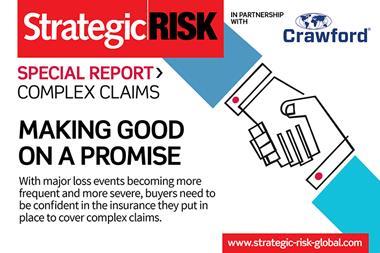In the current climate, procurement teams must find a way to manage the uncertainty of supply price, availability and demand. Risk frameworks are vital but Andrew Leslie finds that the human touch should not be underestimated
If you don’t have the wherewithal to make a product or provide a service, you can’t sell it. If you have no products to sell, you go out of business. If your machinery is worn out or your training programme is cut back, competitors will steal an edge. The process of procurement then, has to be among the most fundamental things that any organisation must get right. In good times, life is relatively easy, for demand can be predicted with a fair degree of accuracy, suppliers will be competing in a thriving market, and the chief worry will be ensuring that you get enough of the material you need at a sustainable price. Even that risk can be offset by drawing up suitable contracts with suppliers, ensuring both them and you of stability and a predictable life. The risk manager may well ignore procurement in favour of more pressing concerns.
In an economic downturn, however, the risks surrounding procurement rapidly multiply. Demand is falling, but estimating whether it will decline gently or suddenly fall off a cliff is plagued by uncertainty on the macro-economic scale. What if the recession becomes a depression? What if government’s attempts to stimulate the economy do not work? What effects might massive cuts in public spending, or high unemployment, have? This fundamental lack of knowledge about the future causes the lights on the procurement risk instrument panel to start flickering red, in the regions of both direct procurement (raw materials, components) and indirect procurement (maintenance, capital goods, services).
As is so often the case in complex systems, positive feedback can rapidly lead to risks becoming critical. A drop in sales or an enforced cut in the price of a product can turn inventory from asset to liabilitiy, while those contracts with suppliers may begin to look more like leg-irons than desirable reassurances of stability. Yet, putting pressure on suppliers may not be wise – for their own financial health may not be what it was. Equally, they may be worried about your ability to survive, and be looking at their credit risk in a new light. Cuts to budgets may mean that maintenance has to be deferred, training schemes cut back, capital expenditure delayed – all of which impact on the ability of a business to remain competitive and in balance.
Meanwhile, those projects that are late and over budget (44% of all US IT projects, according to the 2009 Standish Group’s report) appear ever more damaging. And if a competitor is marginally leaner and more efficient than you, a difference that was barely noticeable during the good years may now become stark.
Procurement risk management
Procurement risk management is not a new idea. One of the most commonly referenced documents in the field describes the procurement risk management framework drawn up by Hewlett-Packard (HP) back in the year 2000 as a way of countering the extreme volatility in flash memory prices due to rising demand from mobile phone manufacturers. The price of the DRAM memory that HP used for its printers dropped by over 90% in 2001 and tripled again in 2002. To ensure availability, HP decided to enter a long-term contract with a major supplier, and had to come up with answers to the classic procurement questions:
• What should we pay over the next few years and how should we structure our payments?
• How much should we buy and how should we structure delivery terms?
• How long a horizon should the contract cover and when is the best time to sign the agreement?
• What provisions should be included to secure compliance?
HP decided that the approach to take involved quantifying the uncertainties surrounding demand, price and availability by looking at various scenarios and estimating the probability of their occurrence. This enabled them draw up their requirements for ‘high-demand’, ‘base-demand’ and ‘low-demand’ contexts, and to structure their contracts with suppliers accordingly. They could guarantee the order for the numbers of components suggested by the ‘low’ scenario, thus being able to negotiate discounts. The scenarios around the ‘base’ demand were dealt with through building flexibility into contracts, with complex staging for numbers and price. For the high-demand scenarios, HP worked out that they would find it cheaper to buy on the spot market or to turn to the recycling industry rather than hold inventory ‘just in case’. Overall, they found that their procurement risk framework meant ‘less inventory, less inventory risk, better service levels to customers, lower costs, and more competitive product pricing. HP supply chain teams estimate that total supply chain costs could be lowered by as much as 20% by this approach.’
But in a sobering 2006 survey for the Chartered Institute of Purchasing and Supply (CIPS), Helen Peck of Cranfield university found that although around 60% of organisations used ongoing reviews of risk in purchasing and supply, “one in five respondents reported no knowledge of any such review having ever been undertaken within their organisations.” The public sector, utilities, and the manufacturing sector were the worst in this respect. The survey also found that:
• Mismatches with information systems or product/service lifecycles were included in less than 40% of supplier risk assessments.
• Less than 40% of organisations considered suppliers’ business continuity planning in risk assessments.
• Less than a third of organisations were likely to routinely monitor their suppliers’ own procurement and risk sharing policies.
Have things changed in the three years since the Cranfield survey? According to an August 2009 survey by Aon and State of Flux, the importance of supply chain risk management has increased significantly (up by 15% to 42% over 2008 in the priority given to it by the firms surveyed). But the same survey reported that only 15% of respondents said they had a complete understanding of their supply chains and where they impact their operations, while 42% reported that they had no key performance indicators in place to monitor supply chain risk.
Helping out the supplier
Monitoring the performance and compliance of suppliers should be second nature for procurement functions, so the fact that in so many cases this does not appear to extend to looking carefully at some of the chief risks posed by potential failures in the supply chain is disturbing. In a recession, these risks are magnified. They are, of course, at their most dangerous where an organisation is over-reliant on a single supplier for a critical component or service. In some cases, this may be because alternative suppliers may be hard to come by, or where switching to an alternative supplier may cause lengthy disruptions.
Rather than face the failure of a supplier, it may be better to try to ensure that the supplier does not fail in the first place, and risk managers should be talking to their colleagues in procurement to make certain that there is awareness of this. It is especially embarrassing if it is your own organisation that causes a vital supplier to fail – a demand from on high to cut procurement costs by 10% may seem manageable, but if that means a cut of 40% to one particular supplier, the consequences may turn out to be worse than the cut. Procurement risk management – if it exists – should be able to argue that the pressure to squeeze suppliers but cutting procurement costs by an arbitrary figure may not be in the best long term interests of the organisation, especially on the reputational front.
Firms that pride themselves on close partnership with their suppliers should have fewer difficulties than those which take an arms-length approach. Although a supplier will naturally try to minimise his difficulties, the habit of sharing information in the good times has a better chance of paying off in bad ones, if he knows he will have a sympathetic audience. Often, cash flow will lie at the heart of the problem. And since suppliers may be finding insurance of their credit risk increasingly hard to come by (12,000 UK businesses had had their cover removed by last March, according to the Financial Times), their worries may be increased by uncertainty about their customers’ position. Taking rapid steps to ensure prompt payment will assuage the worries, ease the cashflow problem, and help in smoothing out problems further down the supply chain.
Procurement and sustainability
Matters of price, availability and continuity of supply may be the most important risks facing the procurement function, but inevitably there are others too. The whole of the public sector is still coming to grips with the European procurement directives, which lay down the manner in which contracts from public sector organisations must be put out to tender in a fashion that is fair and transparent. The regulations themselves may be a relatively simple matter of ensuring compliance to a bureaucratic process, but the emphasis that is placed on sustainability issues ought to be alerting any organisation that has dealings with the public sector to the risks (and opportunities) that are implicit. In a 2008 communication, the Commission defined Green Public Procurement as: “…a process whereby public authorities seek to procure goods, services and works with a reduced environmental impact throughout their life cycle when compared to goods, services and works with the same primary function that would otherwise be procured” – and there is little doubt that promoting sustainability remains a key policy for the Commission. The risk management of the procurement process should ideally be building in parameters for whole-life costs and environmentally ‘clean’ product sourcing and manufacturing processes.
The UK’s Office of Government Commerce note on ‘Environment Issues in Purchasing’ makes it clear, for example, that while public sector procurement is directed to seek ‘best value’, it is not precluded from specifying sustainability or other environmental issues as part of the tendering process. Indeed, it encourages public procurement departments to:
• Develop an environmental purchasing strategy – be clear about how sustainable development fits with other objectives and, in particular, how it fits into the organisation’s overall procurement strategy. This should also reflect wider government priorities.
• Secure commitment to your environmental purchasing strategy at a senior level.
• Consider developing a risk-based approach to enable prioritisation of actions. Look at risks to the environment as well as related risks to reputation and security of supply.
E-procurement
E-procurement, according to its acolytes, is an idea whose time has come. The ability to manage the whole procurement process electronically, from e-sourcing, through e-tendering, to e-payment must tempt any business looking to minimise back-office costs. And EU governments are wholeheartedly behind the idea. The Manchester ministerial declaration of November 2005 states that: “By 2010, all public administrations across Europe will have the capability of carrying out 100 % of their procurement electronically and at least 50 % of public procurement above the EU public procurement threshold will be carried out electronically.” The result is the PEPPOL (Pan-European Public eProcurement On-Line) project, whose aim is to make this vision a reality. It is progressing – although the 2010 deadline looks somewhat over-ambitious – and if you care to search for what individual member states have to report, you will find a number of ‘this folder contains no items’ entries.
Meanwhile, back on the private sector front, this plea from a e-procurement blogger from IT research and advisory firm, Gartner, may more closely reflect reality.
“Today I fielded yet another call from a supplier that is frustrated with and challenged to support all the various buy-side e-procurement and e-invoicing solutions of their customers. ‘We’re a high volume shop,’ they said. ‘It’s not practical for us to log into a dozen different portals to download orders and submit invoices.’ To complicate matters, other customers of this vendor use a variety of networks such as OB10, Ariba and Xign. What they and a steady stream of vendors want is a solution for them, is a B2B e-billing solutions that their customers welcome.”
Like many other areas of life, and of IT life in particular, e-procurement carries risks alongside benefits. During hard times, the relationship between suppliers and their customers requires the human touch. Be careful that enthusiastic adoption of e-procurement does not jeopardise it.



















